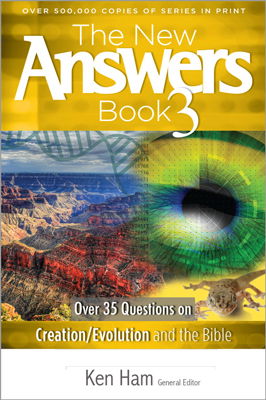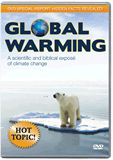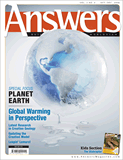
Chapter 7
Is Man the Cause of Global Warming?
Global warming is big news. Should we be worried?
Is global warming real? Is it all caused by man? Should we as Christians care about global warming? What should we do about it?
Global warming is big news. The media, environmentalists, and politicians, such as Al Gore,1 continue to pound away that global warming is real, it is man-caused, and great harm will come to our world because of it. Some even say that global warming is the most significant threat to ever affect man. Bjorn Lomborg quotes respected scientist James Lovelock as saying: “Before this century is over, billions of us will die and the few breeding pairs of people that survive will be in the Arctic where the climate remains tolerable.”2 Intense storms of various sorts, drought, and heat waves will devastate the earth.3
Is all this true? Is global warming real? Is it all caused by man? Should we as Christians care about global warming, and if we do care, what should we do about it?
Man Is a Steward of God’s Creation
We should be concerned with global warming, as well as other environmental issues, simply because God created the universe, the world, and everything in it (Exodus 20:11). It is His creation; He created it directly with a purpose and with man in mind. It did not evolve over billions of years. Man was told right away in the Garden of Eden to take dominion over the earth (Genesis 1:26–28), which means that we are to be stewards of His creation. We are to cultivate and take care of our surroundings, which at that time was the Garden of Eden: “Then the LORD God took the man and put him in the garden of Eden to tend and keep it” (Genesis 2:15).
What Should Christians Do about Global Warming?
Amidst all the hype, Christians need to first apply 1 Thessalonians 5:21: “Test all things; hold fast what is good.” We are to hold fast to God’s Word, the Bible, and Jesus as our Lord and Savior. Then we need to examine the evidence carefully. As stewards of God’s creation, it will take time and energy to find out the facts. It is too easy to accept a superficial analysis of a controversial subject, in which case we might learn just enough to get into trouble. No, we need to dig deeper than the superficial level.
It is no different than evaluating the creation/evolution issue. At the superficial level, evolutionists can paint a pretty picture. It is only when you dig below the surface that you find out that evolution is unsubstantiated.
Since creationists are used to separating data from interpretation (the battle between creation and evolution is not over the data but the interpretation of the data), it is relatively easy to apply the same principles to the global warming issue. So we need to check the real data first. We need to be as objective as possible when examining the data, realizing that bias for man-made global warming and its harms is rampant.4
Evaluating the Data
When we examine the data, what can we say about global warming? This section will evaluate the facts, while the next main section will delve into additional evidence. We will then be able to evaluate global warming.
Carbon Dioxide and Other Greenhouse Gases Have Increased
First, carbon dioxide and other greenhouse gases, such as methane, have increased significantly over the past 100 years (Figures 1a, b). These have been measured continuously since the middle of the 20th century and inferred from proxy indicators before that.

Figure 1a: Annual global temperature from 1850 to July 2009, from the U.K. Met Office Hadley Centre and the Climate Research Unit at the University of East Anglia. Note that temperatures have been cooling since about 2002.
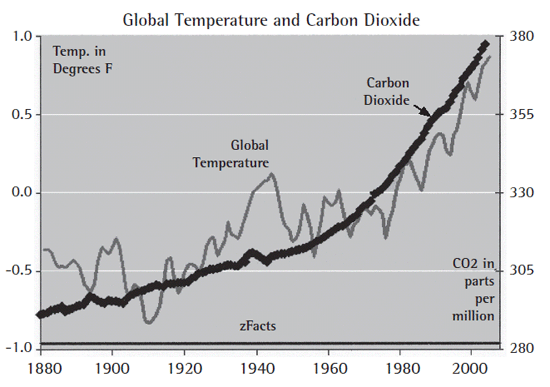
Figure 1b: The increase in carbon dioxide since 1880.
Carbon dioxide has been continuously measured since 1959 and been inferred mainly from tree rings and ice cores before 1959. Note that carbon dioxide has increased more after about 1960 than before. Despite the title of the article from which this graphic is taken, the correlation of CO2 and temperature does not demonstrate a cause-effect relationship.5
Carbon dioxide has been added to the air primarily because of the burning of fossil fuels since the industrial revolution. A secondary source for carbon dioxide is believed to be tropical deforestation. As trees are cut down, they rot and the carbon in the wood is oxidized to carbon dioxide. It is true that forests are being cut down in the tropics, especially in Brazil. However, forests grow back. So, it is not deforestation that counts, but the total amount of forest. When we consider the total amount of forest, the trend is unclear; we cannot be certain if it is increasing or decreasing.6 So the rotting of tropical trees likely is not a significant source of carbon dioxide for the atmosphere.
Carbon dioxide is actually a minor gas in the greenhouse effect. The major greenhouse gas is water vapor, which accounts for 95 percent of greenhouse warming.7 The greenhouse effect is actually good. Without these greenhouse gases the earth would be about 60°F cooler, and we would likely all freeze to death.
It is theoretically true that the increase in carbon dioxide and other greenhouse gases should cause warmer temperatures. The main question is how much.
There Are Natural Causes of Climate Change
A second fact is that there are natural causes of climate change. There are short-period natural processes that change the temperature by about a degree over several years. Two of these are a strong volcanic eruption that causes cooler global temperatures and an El Nińo that causes warmer global temperatures. Volcanism causes cooling by the reflection of sunlight back to space from particles trapped in the stratosphere. The amount of carbon dioxide and water vapor given off during volcanism is insignificant over the space and time periods significant to climate change.
There are also long-period temperature changes caused by effects on the sun that can be correlated to the number of sunspots: the more sunspots, the warmer the temperature on earth and vice versa. Since sunspots are cool spots, heating on earth seems counter intuitive. But when there are many sunspots, there are also many hot spots, called faculae, that more than make up for the cool spots. Two long period temperature changes recognized are the Medieval Warm Period (MWP) from about 800 to 1200 and the Little Ice Age (LIA) from about 1400 to 1880 (Figure 2). These have been based on historical records and are well correlated to the number of sunspots using proxy data.8 Variations in carbon dioxide levels were not responsible for these changes.

Figure 2. Average global temperature for the past 2,000 years showing the Medieval Warm Period (MWP) and the Little Ice Age (LIA). Before about the middle 1800s, there was little change in carbon dioxide to cause these fluctuations.
The climatic effect of natural processes is also seen during the 20th century by comparing the increase in carbon dioxide with the temperature change (Figure 1b). Carbon dioxide increased slowly until after World War II and then accelerated. But the global temperature rose strongly from 1910 to 1940 (remember the dust bowl years in the 1930s), dropped a little between 1940 and 1975 (remember the coming ice age scare), and rose strongly again from 1975 to about 2002. The temperature has generally been cooling from 2002 to 2009 while carbon dioxide in the atmosphere continues to increase substantially. Nicola Scafetta and Bruce West stated that natural cycles from the sun account for at least 50 percent of the 20th century global warming.9
The increase in the amount of sunshine reaching the earth with a large number of sunspots is small. This is why many man-made global warming advocates discount the significance of the sun. It is known that higher sunspot numbers, which cause a stronger solar magnetic field, better shield the earth from cosmic rays. It is possible that fewer cosmic rays result in fewer low clouds that cause warmer surface temperatures and vice versa.10 This hypothesis has been seriously challenged, so only time will tell if the hypothesis stands.
There Is No Consensus of Scientists
Third, although it is commonly claimed that there is a consensus of scientists that blame man for global warming, in actuality there is no consensus at all. Many prominent scientists disagree. Dr. Art Robinson has maintained a website since 1998, signed by around 20,000 scientists, saying that, as of 2009, there is no convincing scientific evidence that greenhouse gases are causing or will cause catastrophic heating of the earth’s atmosphere and disruption of the earth’s climate.11 Of these, over 2,500 are physicists, geophysicists, climatologists, meteorologists, oceanographers, and environmental scientists, who are particularly qualified to evaluate global warming.
Climate Simulations Exaggerate Carbon Dioxide Warming
Fourth, dozens of computer climate simulations have attempted to quantify the relationship between increased carbon dioxide and temperature change. In the simulations, the scientists double carbon dioxide and leave every other variable alone. The resulting temperature changes range from 3°F to 11° F warming, usually by the year 2100.
But these simulations are crude, since the computer models cannot accurately simulate the many types of clouds and their effects, solar and infrared radiation processes, ocean processes, ice processes, etc.12 The strengths and weaknesses of computer models need to be understood, but it seems that those who want runaway global warming believe these models without question.
It is interesting that nature has partially run the experiment for us. Carbon dioxide has increased a little more than 30 percent since the industrial revolution. Other greenhouse gases, not including water vapor, also have increased about 30 percent in “carbon dioxide equivalency units,” for a total increase of about 60 percent in “carbon dioxide.”13 Global warming is claimed to be 1.2°F (yes, you heard right, the warming has been very small so far), but at least half is from natural causes. So if a 60 percent increase in “carbon dioxide” causes only a 0.6 degree Fahrenheit warming (man’s share), a doubling of carbon dioxide should cause a 1°F warming. The models are therefore 3 to 11 times too sensitive to a doubling of carbon dioxide and should not be believed.
Some Benefits of Global Warming
Fifth, despite all the well-publicized harms, there are benefits to global warming. The media typically exaggerate the harms. Take for example the supposed decreasing polar bear populations as a result of less sea ice in the Northern Hemisphere. This was the theme behind the popular movie Arctic Tale.14 Lomborg documents that the polar bear populations actually have increased.15
Some net benefits are that global warming will save the lives of more people, since many more people die of the cold than die of the heat. For instance, in Europe, seven times as many people die of the cold than die of the heat.16 Other benefits include more plant growth due to higher carbon dioxide levels, aiding farming and ranching; crops able to be grown at higher latitudes; and shipping through ice-free areas of the Arctic Ocean, which will save much fuel and money. At this point it is difficult to tell whether there will be a net benefit or a net harm. Only objective research will determine this.
The Cost to “Fight” Global Warming Is Horrendous
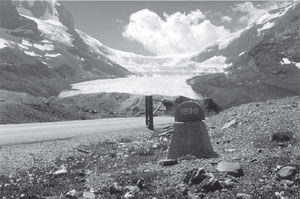
Figure 3: Athabasca Glacier, Canadian Rockies, was near the sign in 1890. It has since melted back to its current location due to global warming.
Sixth, if certain environmentalists and politicians get their way, the cost to “fight” global warming will be horrendous, if the attempt is successful and doesn’t produce even worse side effects. Lomborg estimates the cost of fighting global warming at many trillions of dollars.17 Although Lomborg actually believes in the temperature rises suggested by the computer models, he makes a strong case that this money is best spent elsewhere, and that the earth will adapt to warming.
Additional Evidence
In any analysis of such a controversial subject, there is bound to be uncertainty in some variables. Only four of the most important will be evaluated.
Global Warming Is Real
First, global warming is real. Although some claim there is no global warming or we cannot measure it, the evidence for global warming is compelling. The claimed warming since 1880 is only 1.2°F. But we see the effects of the warming in that practically all glaciers have receded since about 1880 (Figure 3), and the sea ice in the Arctic Ocean has decreased (Figure 4).

Figure 4: Minimum sea ice extent mid-September 2009, compared with the 1979 to 2000 average minimum (courtesy of the National Snow and Ice Data Center). However, the amount of sea ice has recovered 15 percent over 2008, which was about 10 percent greater than the record low in 2007, possibly due to global cooling as shown in Figure 1a.
The recent global warming is not caused by the earth breaking out of the Ice Age18 about 4,000 years ago, because the atmosphere responds very fast to changes that affect climate. The change in seasons is one example of how fast the temperature can change when the angle of the sun changes. The earth has been more or less in steady state since the end of the Ice Age.
However, there is a question of whether the amount of claimed warming is accurate, since there are many biases (mostly favoring warming) in the longterm temperature records. Although those who analyze global temperatures have mostly purged the record of these errors, the claimed warming likely is too warm. Professor Robert Balling has studied these biases for a long time and has concluded:
But as this chapter makes clear, major problems remain. First, the temperature records are far from perfect and contain contaminations from urbanization, distribution of measurement stations, instrument changes, time of observation biases, assorted problems in measuring near-surface temperatures in ocean areas, and on and on. This could introduce a total bias of 0.2°C to 0.3°C, or about one-third of the observed warming.19
This means that global warming since 1880 may be only about 0.8°F, which is closer to the satellite and weather balloon data of the lower atmosphere.
The Lower Atmosphere is Warming Less than 1.2°F
Second, satellites have been measuring the amount of temperature change in the atmosphere since 1979. Weather balloons have been probing the atmosphere for longer than that. At first, it was thought that the satellite temperatures showed a cooling trend. However, there were some errors in the measurements. Now, it appears that the satellite and weather balloon data both show less warming in the lower atmosphere than the claimed 1.2°F surface warming.20
The Climate Likely Cannot Jump to a More Catastrophic Mode
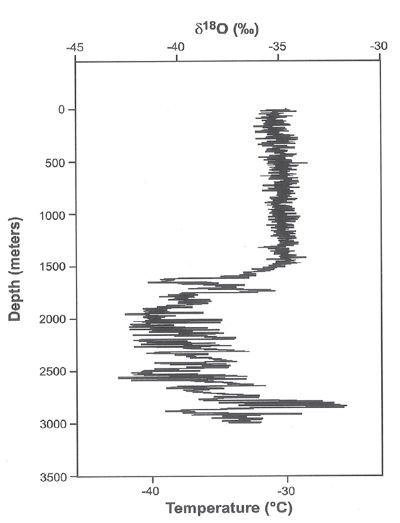
Figure 5: The oxygen isotope ratio from bedrock to the top of the GISP2 ice core at Summit on the Greenland Ice Sheet (plot courtesy of Dr. Larry Vardiman). The oxygen isotope ratio is generally proportional to temperature with cooler temperatures to the left.
Third, some scientists have concluded that the atmosphere goes through thresholds to different climatic states. They believe that although our climate has been steady, global warming may bring the temperature up to the “tipping point” that will cause a shift to a much different climate, possibly leading to an ice age. The threshold idea is based on Greenland ice cores showing large, abrupt changes in temperature during the Ice Age portion (Figure 5).
Some suggest that global warming will halt the Gulf Stream that transports warm water into the high North Atlantic Ocean. Temperatures then plummet in Europe and an ice age can occur. This is the basis of the movie The Day After Tomorrow,21 taken from the preposterous book The Coming Global Superstorm. 22 Despite Hollywood fantasy, some scientists believe that such a scenario is possible over a time frame of a decade or two.
The idea of an abrupt climate change after the temperature passes a “threshold” is where the worldview issue between creation and evolution is crucial. Evolutionary scientists date the ice cores at hundreds of thousands of years old, and the ice sheets are believed to have been more or less the same thickness for millions of years. But these abrupt temperature changes in the ice cores are due to a rapid, post-Flood Ice Age and are only related to changes during a unique Ice Age.23
Storms and Droughts Likely Unchanged
Fourth, it seems like every large storm, drought, or heat wave that occurs in the world is blamed on man-made global warming. But these things have been happening for millennia. The problem is that most people have short memories about past events. Furthermore, damage is greater now because more people and property lie in harm’s way. But overall, there do not seem to be any long-term trends in any of these weather events.24
Summary
In the face of claims that man is causing disastrous global warming, an objective look at the facts and additional evidence show otherwise. Natural processes on the sun account for over 50 percent of the claimed 1.2°F global warming, which is likely too warm. Since the climate simulations greatly exaggerate the temperature rise from an increase in carbon dioxide, these models cannot be trusted. Thus, man is likely responsible for only about 0.5°F warming—miniscule and likely impossible to mitigate.
What is really needed is unbiased research in climate change. Climate disaster is not just around the corner; we have sufficient time for careful research.
Acknowledgment
I thank Drs. Larry Vardiman and Jason Lisle for reviewing the manuscript and offering valuable improvements.
The New Answers Book 3
Do you have answers to the big questions about the Christian faith, evolution, creation, and the biblical worldview?
Read Online Buy BookFootnotes
- Al Gore, An Inconvenient Truth: The Planetary Emergency of Global Warming and What We Can Do About It (New York, NY: Rodale Press, 2006).
- B. Lomborg, Cool It: The Skeptical Environmentalist’s Guide to Global Warming (New York, NY: Alfred A. Knopf, 2007), p. 41.
- N. Shute, “The Weather Turns Wild,” U.S. News & World Report, February 5, 2001, p. 44–52.
- J. Pena and R. Vogel, eds., Global Warming: A Scientific and Biblical Exposé of Climate Change (DVD), Coral Ridge Ministries and Answers in Genesis, 2008; L. Vardiman, Some Like It Hot (Dallas, TX: Institute for Creation Research, 2009); M.J. Oard, “Global Warming: Examine the Issue Carefully,” Answers, October–December 2006, p. 24–26.
- ZFacts, “Evidence that CO2 Is Cause,” www.zfacts.com/p/226.html.
- A. Granger, “Difficulties in Tracking the Long-term Global Trend in Tropical Forest Area,” Proceedings of the National Academy of Science 105 no. 2 (2008): 818–823.
- P.J. Michaels and R.C. Balling Jr., The Satanic Gases: Clearing the Air About Global Warming (Washington, D.: Cato Institute, 2000), p. 25–28.
- C. Loehle and J.H. McCulloch, “Correction to a 2000-year Global Temperature Reconstruction Based on Non-tree Ring Proxies,” Energy & Environment 19 no. 1 (2008): 93–100.
- N. Scafetta and B. West, “Is Climate Sensitive to Solar Variability?” Physics Today 61 no. 3 (2008): 50–51.
- H. Svensmark, “Cosmoclimatology: A New Theory Emerges,” Astronomy and Geophysics 48 no. 1 (2007): 18–24; L. Vardiman, “A New Theory of Climate Change,” Acts & Facts 37 no. 11 (2008): 10–12.
- Global Warming Petition Project, www.petitionproject.org.
- Michaels and Balling, The Satanic Gases: Clearing the Air About Global Warming, p. 55–73.
- Ibid., p. 27.
- M.J. Oard, movie review: “Arctic Tale—Exaggerating the Effects of Global Warming,” www.answersingenesis.org/articles/aid/v2/n1/arctic-tale.
- Lomborg, Cool It: The Skeptical Environmentalist’s Guide to Global Warming, p. 3–9.
- Ibid., p. 17.
- Ibid, p. 32–38.
- M.J. Oard, Frozen In Time: The Woolly Mammoth, the Ice Age, and the Biblical Key to Their Secrets (Green Forest, AR: Master Books, 2004).
- R.C. Balling Jr., “Observational Surface Temperature Records Versus Model Predictions,” in P.J. Michaels, ed., Shattered Consensus: The True State of Global Warming (New York, NY: Rowman & Littlefield Publishers, Inc, 2005), p. 67.
- J. Christy, “Temperature Changes in the Bulk of the Atmosphere,” in P.J. Michaels, ed., Shattered Consensus: The True State of Global Warming (New York, NY: Rowman & Littlefield Publishers, Inc, 2005), p. 72–105.
- M.J. Oard, “The Greenhouse Warming Hype of the Movie The Day After Tomorrow,” Acts & Facts Impact, 373 (Dallas, TX: Institute for Creation Research, 2004).
- A. Bell and W. Strieber, The Coming Global Superstorm (New York, NY: Pocket Books, 2000).
- M.J. Oard, The Frozen Record: Examining the Ice Core History of the Greenland and Antarctic Ice Sheets (Dallas, TX: Institute for Creation Research, 2005).
- P.J. Michaels, The Predictable Distortion of Global Warming by Scientists, Politicians, and the Media (Washington DC: CATO Institute, 2004).
Recommended Resources

Answers in Genesis is an apologetics ministry, dedicated to helping Christians defend their faith and proclaim the good news of Jesus Christ.
- Customer Service 800.778.3390
- Available Monday–Friday | 9 AM–5 PM ET
- © 2025 Answers in Genesis

